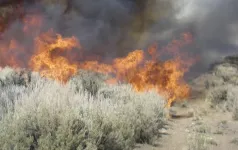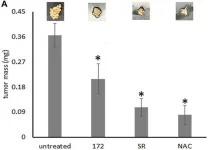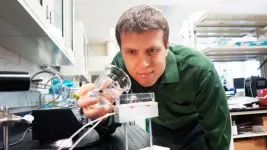(Press-News.org) Global carbon emissions from fossil fuels have risen again in 2023 – reaching record levels, according to new research from the Global Carbon Project science team.
The annual Global Carbon Budget projects fossil carbon dioxide (CO2 emissions of 36.8 billion tonnes in 2023, up 1.1% from 2022.
Fossil CO2 emissions are falling in some regions, including Europe and the USA, but rising overall – and the scientists say global action to cut fossil fuels is not happening fast enough to prevent dangerous climate change.
Emissions from land-use change (such as deforestation) are projected to decrease slightly but are still too high to be offset by current levels of reforestation and afforestation (new forests).
The report projects that total global CO2 emissions (fossil + land-use change) will be 40.9 billion tonnes in 2023.
This is about the same as 2022 levels, and part of a 10-year “plateau” - far from the steep reduction in emissions that is urgently needed to meet global climate targets.
The research team included the University of Exeter, the University of East Anglia (UEA), CICERO Center for International Climate Research, Ludwig-Maximilian-University Munich and 90 other institutions around the world.
“The impacts of climate change are evident all around us, but action to reduce carbon emissions from fossil fuels remains painfully slow,” said Professor Pierre Friedlingstein, of Exeter’s Global Systems Institute, who led the study.
“It now looks inevitable we will overshoot the 1.5°C target of the Paris Agreement, and leaders meeting at COP28 will have to agree rapid cuts in fossil fuel emissions even to keep the 2°C target alive.”
How long until we cross 1.5°C of global warming?
This study also estimates the remaining carbon budget before the 1.5°C target is breached consistently over multiple years, not just for a single year.
At the current emissions level, the Global Carbon Budget team estimates a 50% chance global warming will exceed 1.5°C consistently in about seven years.
This estimate is subject to large uncertainties, primarily due to the uncertainty on the additional warming coming from non-CO2 agents, especially for the 1.5°C targets which is getting close to the current warming level.
However, it’s clear that the remaining carbon budget – and therefore the time left to meet the 1.5°C target and avoid the worse impacts of climate change – is running out fast.
Professor Corinne Le Quéré, Royal Society Research Professor at UEA’s School of Environmental Sciences said: “The latest CO2 data shows that current efforts are not profound or widespread enough to put global emissions on a downward trajectory towards Net Zero, but some trends in emissions are beginning to budge, showing climate policies can be effective.
“Global emissions at today’s level are rapidly increasing the CO2 concentration in our atmosphere, causing additional climate change and increasingly serious and growing impacts.”
“All countries need to decarbonise their economies faster than they are at present to avoid the worse impacts of climate change."
Other key findings from the 2023 Global Carbon Budget include:
Regional trends vary dramatically. Emissions in 2023 are projected to increase in India (8.2%) and China (4.0%), and decline in the EU (-7.4%), the USA (-3.0%) and the rest of the world (-0.4%).
Global emissions from coal (1.1%), oil (1.5%) and gas (0.5%) are all projected to increase.
Atmospheric CO2 levels are projected to average 419.3 parts per million in 2023, 51% above pre-industrial levels.
About half of all CO2 emitted continues to be absorbed by land and ocean “sinks”, with the rest remaining in the atmosphere where it causes climate change.
Global CO2 emissions from fires in 2023 have been larger than the average (based on satellite records since 2003) due to an extreme wildfire season in Canada, where emissions were six to eight times higher than average.
Current levels of technology-based Carbon Dioxide Removal (ie excluding nature-based means such as reforestation) amount to about 0.01 million tonnes CO₂, more than a million times smaller than current fossil CO2 emissions.
The Global Carbon Budget report, produced by an international team of more than 120 scientists, provides an annual, peer-reviewed update, building on established methodologies in a fully transparent manner.
The 2023 edition (the 18th annual report) will be published in the journal Earth System Science Data.
END
Fossil CO2 emissions at record high in 2023
2023-12-05
ELSE PRESS RELEASES FROM THIS DATE:
Interpreting the afterglow of a black hole’s breakfast
2023-12-05
An entirely new way to probe how active black holes behave when they eat has been discovered by an international team of astronomers.
A sample of active black holes at the centre of 136 galaxies were found to shine in microwave and X-ray light in the same way, no matter their appetite for the surrounding galactic matter like gaseous clouds of dust and plasma.
Led by scientists at Cardiff University, the team says the process is not something predicted by our current understanding of how black holes ...
NASA audio specialist named in Forbes 30 Under 30 List of Innovators
2023-12-04
Katie Konans, NASA’s audio and podcasting lead at the agency’s Goddard Space Flight Center in Greenbelt, Maryland, is one of two NASA employees named to Forbes’ 30 Under 30 Class of 2024. The other agency honoree, Clare Luckey, is a systems engineer at NASA’s Johnson Space Center in Houston.
Forbes’ 30 Under 30 list is a selection of young, creative, and bold minds the magazine’s experts consider revolutionaries, changing the course of business and society. Forbes evaluated more than 20,000 nominees to decide on 600 business and industry figures, with 30 selected in each of 20 industries.
“When I joined ...
Supercomputing training at Argonne National Laboratory
2023-12-04
Fatima Bagheri, a National Science Foundation (NSF) postdoctoral fellow at The University of Texas at Arlington, was one of 75 students selected to attend an intensive program on supercomputing at the Argonne National Laboratory in Chicago.
With support from the Department of Energy’s Exascale Computing Program, Bagheri participated in the Argonne Training Program on Extreme-Scale Computer (ATPESC) aimed at teaching attendees the ins and outs of using the latest supercomputers. Bagheri said she came to ATPESC to expand her knowledge of high-performing computers (HPC) like ...
Most adults eligible for statins for prevention are not using them
2023-12-04
Embargoed for release until 5:00 p.m. ET on Monday 4 December 2023
Annals of Internal Medicine Tip Sheet
@Annalsofim
Below please find summaries of new articles that will be published in the next issue of Annals of Internal Medicine. The summaries are not intended to substitute for the full articles as a source of information. This information is under strict embargo and by taking it into possession, media representatives are committing to the terms of the embargo not only on their own behalf, but also on behalf of the organization they represent.
----------------------------
1. ...
EMBARGOED: CAR-T not cost-effective as second-line therapy for diffuse large B-cell lymphoma at current prices, study finds
2023-12-04
EMBARGOED: December 4, 2023, 5PM EST
Contact:
Nicole Oliverio, Dana-Farber Cancer Institute
617-257-0454, nicole_oliverio@dfci.harvard.edu
CAR-T not cost-effective as second-line therapy for diffuse large B-cell lymphoma at current prices, study finds
RESEARCH SUMMARY
Study Title: Peripheral blood TCR clonotype diversity as an age-associated marker of breast cancer progression
Publication: Annals of Internal Medicine, Click here for link
Dana-Farber Cancer Institute authors include: Amar H. Kelkar, MD, MPH (first author); Edward R. Scheffer Cliff, MBBS, MPH; Caron A. Jacobson, MD; Gregory A. Abel, MD, MPH; Corey Cutler, MD, MPH (senior author); and Robert Redd, MS.
Summary: Chimeric ...
Strange burn: new research identifies unique patterns in Utah wildfires
2023-12-04
For a century fire ecologists have worked to decipher a complex question — what does a “normal'' wildfire year look like in the West? That’s a hard question to answer for many reasons, but new research from a team in the Quinney College of Natural Resources shows that thanks to the state’s unique landscapes, Utah’s wildfire patterns may never fit into what is considered “normal” for other Western states.
Utah landscapes are diverse — from dense forests of pinyon-juniper to scattered patches of sagebrush and grasslands, Utah’s variable topography produces ...
New study identifies the greatest threat to wildlife across North America and Canada: people
2023-12-04
You see posts like these on neighborhood Facebook pages all the time: “An owl just flew into my window and appears stunned! Help!” or “I found a baby squirrel on the ground after the wind storm last night. Who do I call?” The answer is a local wildlife rehabilitation center—licensed individuals and organizations that take in hundreds of thousands of sick and injured wild animals nationwide each year. Wildlife rehabilitators see the highest number and greatest range of species of any government or nonprofit organization in the country, giving them unique insight into animal health—and making them great bellwethers of what’s ...
ORNL engineer Karen White honored with Lifetime Achievement Award
2023-12-04
Oak Ridge National Laboratory’s Karen White, who works in ORNL’s Neutron Science Directorate, has been honored with a Lifetime Achievement Award.
White, who manages the section that provides the machine controls,, computing infrastructure, and protection systems across all neutron science technical areas, received the award during the biennial International Conference on Accelerator and Large Experimental Physics Control Systems, held October 7-13, 2013, in Cape Town, South Africa. The award by ICALEPCS honors and celebrates an individual or individuals ...
Osteopontin induces mitochondrial biogenesis in deadherent cancer cells
2023-12-04
“Here, we study the induction of mitochondrial biogenesis by Osteopontin variants in deadherent breast tumor cells.”
BUFFALO, NY- December 4, 2023 – A new research paper was published in Oncotarget's Volume 14 on December 1, 2023, entitled, “Osteopontin induces mitochondrial biogenesis in deadherent cancer cells.”
Metastasizing cells display a unique metabolism, which is very different from the Warburg effect that arises in primary tumors. Over short time frames, oxidative phosphorylation and ATP generation are prominent. Over longer time frames, mitochondrial biogenesis becomes a pronounced ...
Boiled bubbles jump to carry more heat
2023-12-04
Water is often the go-to resource for heat transfer, being used in large-scale cooling operations like data centers that power the internet and nuclear power plants that power cities. Discovering dynamic phenomena to make water-based heat transfer more energy and cost efficient is the ongoing work of Jonathan Boreyko, associate professor and John R. Jones III Faculty Fellow in mechanical engineering.
Boreyko and his team have published extensively on the topic of water and the way it can move, with members of his Nature-Inspired ...





